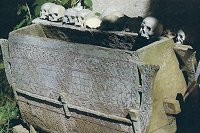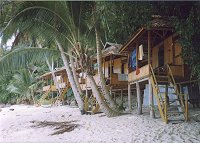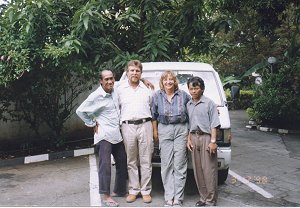 Sulawesi - the
wind-blown orchid of
Indonesia.
Sulawesi - the
wind-blown orchid of
Indonesia.
November 1998
At 4.a.m. on our last morning in Sulawesi we were woken by the amazing noises of the awakening rain forest. Strange honks, screeches, whistles, wheezes and whirrings and then by 5 a.m. we were on the trail of a seriously endangered bird. The Maleo, a black and pink chicken-sized bird lays eggs in warm earth rather than going to the bother of making a nest and sitting incubating for about 21 days! A good idea … except that the thermal vents of Mt Ambang are under threat from human expansion, the locals like eating the adult birds as an alternative to chicken and they like the eggs even more as they are the size of 7 hens eggs and feed the family. We arrived at the hot springs area and saw three maleo still up in the trees where they had roosted overnight. They spend Daytime in the verdant undergrowth and are then very difficult to see. They were large rather ungainly birds as they walked along the branches and definitely pink on the breast so they weren't chickens! Sadly no one has the money or the inclination to protect the few birds that remain.
Sulawesi is one of the islands in Indonesia and an easy two-hour flight from Singapore. It straddles the Equator and has rain forests, wonderfully terraced rice fields, stunning diving locations, the worst roads in the Southern Hemisphere and a fascinating cultural heritage. We chose to go there after an idle on the Internet drew our attention to its existence!
It's an oddly shaped island
likened by some to a drunken spider, a scarecrow in a hurricane or the petals
of a wind blown orchid. Historically it 'belonged' to the Dutch and was known
as Celebes or the Spice Islands until it's independence in 1950. In the
interior, contact between the European powers and the locals was virtually
non-existent. The Torajans, for
example, were not brought under Dutch
administrative control until about 1912. Tana Toraja is a beautiful area
surrounded by rain forest mountains and lush valleys and lived in by people
who build extraordinary boat shaped houses, spend their money on elaborate
funeral ceremonies and place their dead in holes carved in the limestone
cliffs. We spent 10 days in Toraja touring from village to village learning
from our Torajan guide about the unique cultural heritage of the area. Not for
the squeamish or vegetarians is the funeral ceremony. We were invited to one
for a middle class man who had died a year earlier and been kept in a room of
his house until the family had amassed enough money to give him an appropriate
funeral. During the year he is referred to as "the sick one" and the more
sacrifices given at his funeral the better his entry to the afterlife. (A
sacrifice of up to 40 water buffaloes as well as loads of pigs and chickens
would give one quite a good ticket to the afterlife!) As we reached the
funeral the third buffalo of the morning had just been killed by a single cut
to the throat and it was lying on the ground in a pool of blood being skinned
prior to being hacked up for barbequeing. It was gruesome to watch and made
worse by the sound of squealing pigs - stage left - who were also being
sacrificed. In one village that we visited, two weeks after there had been a
funeral there, the stench of blood, urine, fear and death still hung heavily.
After the ceremony the relations put the deceased in a coffin on a ledge or in
a rock crevice and then place a life-sized wooden effigy of the person in an
inaccessible rock niche. The effigies or 'tau-tau' have arms outstretched, in
a demand for yet more animal sacrifices! Babies that die before they have cut
any teeth are placed in a chiseled hole in a living tree for it to grow around
them. When we asked our guide about these unusual practices he always made
them sound reasonably logical!
Trekking around the villages we were impressed by the beauty in line, form and colour of the rice paddies as they followed the natural contours of the valleys. Visually it was truly beautiful, but one couldn't help thinking about the sheer physical toil necessary to construct and maintain the paddies to grow, plant, harvest and dry the rice. Knee deep in watery slime the farmers were turning clods of mud to prepare the paddies for rice planting. Barefoot, too! I heard that they lace their food with marihuana to help combat the pain from bending all day in the fields! Small children were also encouraged to be part of the family team and were often responsible for grinding the outer layer of husk off the rice grains and then winnowing it.
In every village there is either
an infant or junior school and all children wear the school uniform, typically
a white blouse and maroon pleated skirt or white shirt and maroon shorts and
some walk for miles to get to school. They look beautiful with large dark
eyes, dusky skin and a smile never far from their lips. The quality of their
education was not easy to assess. Classrooms were bare except for
desks and chairs. I never saw a single piece of children's work on the walls
or windows and whatever time of day we went past a school, there were always
children outside - just playing. In true ex-teacher mode I started to mutter
"If I was a parent, I'd be asking a few serious questions about the standards
of teaching and learning here …" and "I'm sure Ofsted would be failing schools
left, right and centre!" But then I started to wonder what these children were
being 'educated' for and whether it does them a service when all they have to
look forward to is the endless grind in the paddy fields?
Classrooms were bare except for
desks and chairs. I never saw a single piece of children's work on the walls
or windows and whatever time of day we went past a school, there were always
children outside - just playing. In true ex-teacher mode I started to mutter
"If I was a parent, I'd be asking a few serious questions about the standards
of teaching and learning here …" and "I'm sure Ofsted would be failing schools
left, right and centre!" But then I started to wonder what these children were
being 'educated' for and whether it does them a service when all they have to
look forward to is the endless grind in the paddy fields?
Our trip through the island was organised for us and we had the services of a guide, car and driver for the whole month. Their salaries were pathetic in western terms - a mere £6.50 a day, exclusive of food and lodging! It made the travelling very civilised as we sat in air-conditioned comfort and someone else had to negotiate the appalling roads. If you hear the title 'Trans Sulawesi Highway' it conjures up a vision of a wide, efficient communication route. Wrong. It is a joke! A few small pieces of dual carriageway exist near the 3 main towns, but otherwise the roads have pot-holed surfaces, convoluted routes, few signposts and in some places the surface has disintegrated into a mud bath! It took our driver 2 ½ nerve-racking hours to travel 70 km through mud slides, rock falls and some patches where the road had been reduced to single track! On our last day we flew the 1800km from the North to the South in 1 hour 20 minutes; our driver and guide were not looking forward to 4 days arduous driving to get back!
Alfred Russell Wallace, the Victorian naturalist, wrote down his first ideas on evolution after visiting Manado in North Sulawesi and his letters to Charles Darwin in England prompted Darwin to publish the Origin of Species. It was easy to see how the rich diversity of fauna and flora fascinated the early explorers of these islands. Seeing black peppers, cocoa pods, coffee beans, nutmeg and cloves drying on sacking at the side of the roads became normal. Sir Francis Drake in 1580 sailing the Golden Hind loaded 6 tons of cloves to take back to England, but had to jettison 2 valuable tons to float the boat off a coral reef!
 The book 'Diving in Indonesia'
doesn't mention the Togean islands as a diving /snorkelling destination. Long
may it stay that way, as the islands are still unspoilt, the coral is
pristine, the water is crystal clear, the fish colourful and numerous and the
accommodation is basic! We spent four very happy days in a simple bamboo hut
with a cold mandi (more of those later!) and small kerosene night lamp, eating
a diet of boiled fish, boiled rice and boiled vegetables. By the second day I
was already fed up with the menu! Nevertheless the snorkelling was wonderful,
the varieties of hard and soft corals, sea-shells, brightly coloured fish and
deliciously warm water made it hard to get out of the water! The problem with
the Togeans is their inaccessibility. But it is also their
saviour.
The book 'Diving in Indonesia'
doesn't mention the Togean islands as a diving /snorkelling destination. Long
may it stay that way, as the islands are still unspoilt, the coral is
pristine, the water is crystal clear, the fish colourful and numerous and the
accommodation is basic! We spent four very happy days in a simple bamboo hut
with a cold mandi (more of those later!) and small kerosene night lamp, eating
a diet of boiled fish, boiled rice and boiled vegetables. By the second day I
was already fed up with the menu! Nevertheless the snorkelling was wonderful,
the varieties of hard and soft corals, sea-shells, brightly coloured fish and
deliciously warm water made it hard to get out of the water! The problem with
the Togeans is their inaccessibility. But it is also their
saviour.
Although acres of natural rain forests have disappeared, there still seemed a lot left! The variety of plant and animal life is extraordinary. I was very keen to get to see some of the endemic birds and had specially asked - well in advance of the holiday - for a knowledgeable 'birder' guide. Delightful though he turned out to be, as soon as our young Torajan guide said "Ah! A pecker wood?" I knew we had a novice! But he made up for his lack of expertise with unfailing good humour, enthusiasm and keen sight. "Iris, look - ups there!" was a frequent call as we walked around. Unforgettable, once you have heard it is the whoosh of the large black and white Red Knobbed Hornbill. Males carry a huge red and yellow beak above a bright blue chin, and their wings only have primary flight feathers, hence the unmistakable noise as they fly overhead. These glorious birds are not under any threat at the moment and are really easy to find. I was delighted to track down a few different Mynas, as well. Mynas belong to the starling family, and the Fiery-browed Myna prefers higher elevations, where its bold orange blaze across its brow is unmistakeable. Then there was the 'preacher bird' - a Myna with a startling white collar and "pop 'n whistle" call and finally, the joy of seeing a large flock of noisy, gregarious Finch-billed Mynas squabbling for holes in a dead tree. These are just some of my birding highlights, and gave me great pleasure.
Another memorable stop was at a National Park where by the light of a torch, we went into dense primary jungle with a local guide to find the Tarsius spectrum, at 13cm the smallest carnivorous primate in the world. We were glad to be led by the N.P. guide as in the darkness the various noises were strange and scary. The tiny tarsius are playful at night and a small family group of them were soon located as they jumped from branch to branch above us squealing and squeaking with pleasure. Most of their 13 cms seems taken up with huge eyes and ears, and keeping track of them in the light beam was difficult.
India was full of human smells but despite so many lifestyle parallels the smells in Indonesia are infinitely better! Even many poor dwellings have a mandi. It's a bit like a bathroom with a large tiled sink and the porcelain base of a toilet (no seat or cover) The sink or mandi is used purely for holding cold water. Toilets are flushed with a couple of scoops of water and showers are taken with a few scoops of water! Sometimes it was OK using cold water for showering - particularly when we were hot and sweaty, but first thing in the morning? Wherever we went there were streams or rivers and nearly all the washing is done in them. So much so that the sheets and towels in our accommodation often had a lingering riverine quality! We had some laundry done - very cheaply - but it too had a similar bouquet.

All in all we had a wonderful experience and felt that with Tino's patient and well-informed responses to our frequent questions we had scratched a little bit of Sulawesi's surface.
Return to Contents